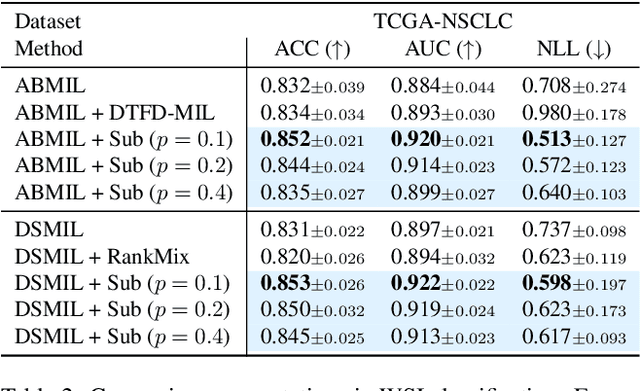Soojeong Lee
Slot-Mixup with Subsampling: A Simple Regularization for WSI Classification
Nov 29, 2023



Abstract:Whole slide image (WSI) classification requires repetitive zoom-in and out for pathologists, as only small portions of the slide may be relevant to detecting cancer. Due to the lack of patch-level labels, multiple instance learning (MIL) is a common practice for training a WSI classifier. One of the challenges in MIL for WSIs is the weak supervision coming only from the slide-level labels, often resulting in severe overfitting. In response, researchers have considered adopting patch-level augmentation or applying mixup augmentation, but their applicability remains unverified. Our approach augments the training dataset by sampling a subset of patches in the WSI without significantly altering the underlying semantics of the original slides. Additionally, we introduce an efficient model (Slot-MIL) that organizes patches into a fixed number of slots, the abstract representation of patches, using an attention mechanism. We empirically demonstrate that the subsampling augmentation helps to make more informative slots by restricting the over-concentration of attention and to improve interpretability. Finally, we illustrate that combining our attention-based aggregation model with subsampling and mixup, which has shown limited compatibility in existing MIL methods, can enhance both generalization and calibration. Our proposed methods achieve the state-of-the-art performance across various benchmark datasets including class imbalance and distribution shifts.
Learning Missing Modal Electronic Health Records with Unified Multi-modal Data Embedding and Modality-Aware Attention
May 04, 2023Abstract:Electronic Health Record (EHR) provides abundant information through various modalities. However, learning multi-modal EHR is currently facing two major challenges, namely, 1) data embedding and 2) cases with missing modality. A lack of shared embedding function across modalities can discard the temporal relationship between different EHR modalities. On the other hand, most EHR studies are limited to relying only on EHR Times-series, and therefore, missing modality in EHR has not been well-explored. Therefore, in this study, we introduce a Unified Multi-modal Set Embedding (UMSE) and Modality-Aware Attention (MAA) with Skip Bottleneck (SB). UMSE treats all EHR modalities without a separate imputation module or error-prone carry-forward, whereas MAA with SB learns missing modal EHR with effective modality-aware attention. Our model outperforms other baseline models in mortality, vasopressor need, and intubation need prediction with the MIMIC-IV dataset.
 Add to Chrome
Add to Chrome Add to Firefox
Add to Firefox Add to Edge
Add to Edge